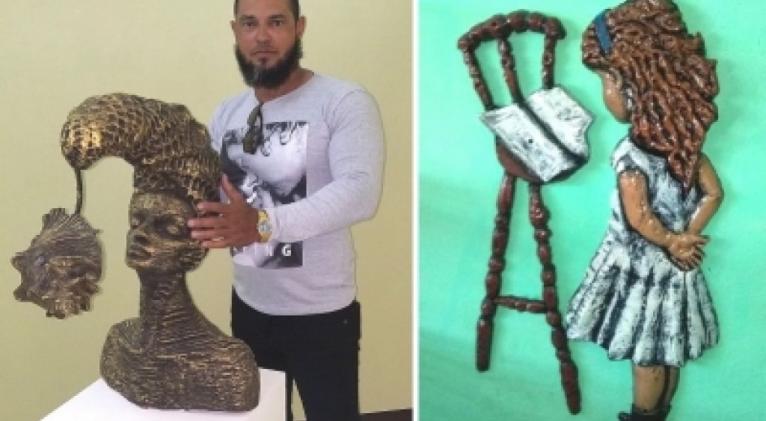Cuba is culture: Homeland and life in Luis Aragon’s ceramics
especiales

Hundreds of craftsmen across our archipelago successfully cultivate artistic ceramics, endeavor in which several cities stand out, among them Matanzas, Trinidad, Camagüey, Havana and Santiago de Cuba. Luis Aragon Tellez is from the latter, but he’s little known nationwide in spite of the unquestionable strength and quality of his works, in which he approaches the most varied topics through a formal diversity, without denying the very nature of the material. Among his iconographies there stand out the tree-dimensional ones of different formats, many of them recreated in renowned personalities of history and culture.
In his small workshop located in the basement of one of the 18-storey buildings in central Garzon Avenue, in the Hero City, this restless and dreamy artist handles clay with amazing creative skill, in a sort of mystic sharing from which a diversity of projects emerge, as much of utilitarian nature as artistic, or the combination of both, in order to create exciting aesthetic experiences in the spectators that allow them to enjoy the striking ennoblement of clay in his hands.
He graduated as mid-level craft technician at “Pepito Tey” Polytechnic School, in Santiago de Cuba (2001) and many of his sculptural pieces have been placed in different squares and institutions of that eastern city, where there stand out those recreated on the Maceo Grajales family, like the bust of Mariana located in Maceo’s Seat of Honor in the Social House of Mothers of the Martyrs; as well as the piece entitled “Las Marianas de estos tiempos” (The Marianas of These Times), placed at the Center for Antonio Maceo Grajales Studies, which gave him a recognition for having contributed with his work to preserve the historical memory of the emblematic mambi (patriotic) family.
Several busts inspired by the National Hero of Cuba, Jose Marti, as well as other artistic ceramic productions related to Santiago de Cuba’s culture, education, public health and society, also enrich the curriculum of this maker, who started as a potter turner in 2003 at Caguayo Foundation. Then, he joined the Cuban Association of Craft Artists (ACAA) in 2009, after participating in numerous individual and group exhibitions.
The soundness of his craft and sculptural endeavor has allowed him to be in great demand to decorate several places in Santiago, such as Bohio de La Trova (Trova Hut), Cabildo Teatral (Town Hall Theater), la Unidad Presupuestada de Apoyo a la Actividad Cultural (the Budgeted Unit to Support Cultural Activities), “America Domitro” Library, “Felix Varela Morales” Junior High School, Casa de la Cultura “Miguel Matamoros” (Miguel Matamoros Culture House), where unconceivably his impressive bust inspired by Jose Marti, erected there, was replaced by an ordinary and poor figure of the Apostle made of plaster.
Throughout 2016 and 2017, Luis acted as plastic arts instructor at the Municipal Directorate in Santiago de Cuba and has collaborated for several years with literary project “Vuelos de mujer” (Woman’s Wings), whose annual awards consist of a piece donated by this maker, who is a recurrent guest at Fire Art biennales, convened by ACAA’s branch in Matanzas.
Entrepreneurial and simple man, he works with clay as if it were a game in which he exercises his craft skills to turn it into an art that, as stated Alejandro G. Alonso —director of the National Museum of Artistic Ceramics for many years until his death—, “It is not decorative art, or applied art, or craft only”. It’s much more.
It’s worth recalling that artistic ceramics began in Cuba in the late 1940s, under the auspices of Dr. Juan Miguel Rodríguez de la Cruz, a respectable physician who had a workshop for those aims in the capital’s outlying neighborhood of Santiago de las Vegas, where such renowned artists as Wifredo Lam, Amelia Pelaez, Mariano Rodríguez and Rene Portocarrero, among others, participated with him in the decoration of utilitarian objects. That place shaped this art expression that has spread across the archipelago and that still needs a better recognition within the visual arts of the island more than 70 years later.
Translated by Jorge Mesa Benjamin / CubaSi Translation Staff













Add new comment